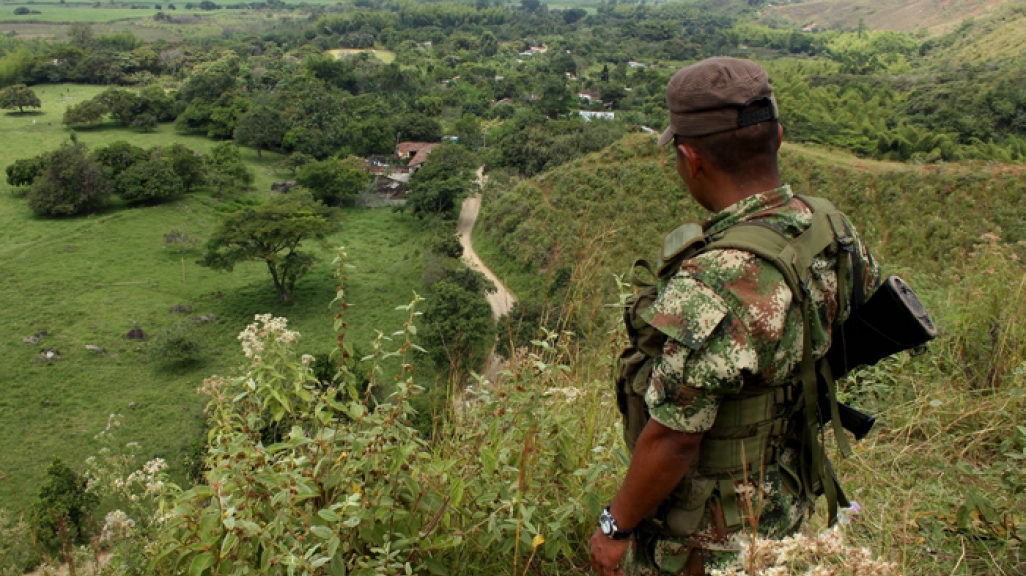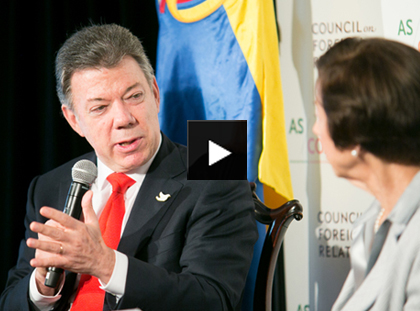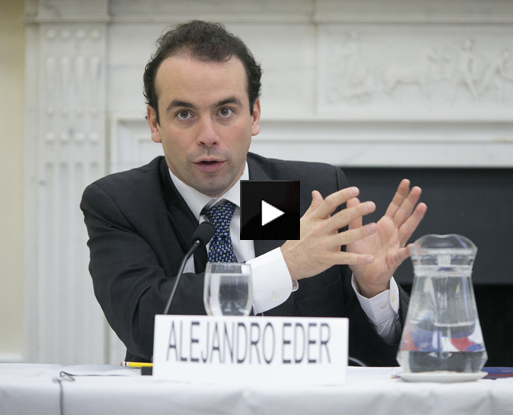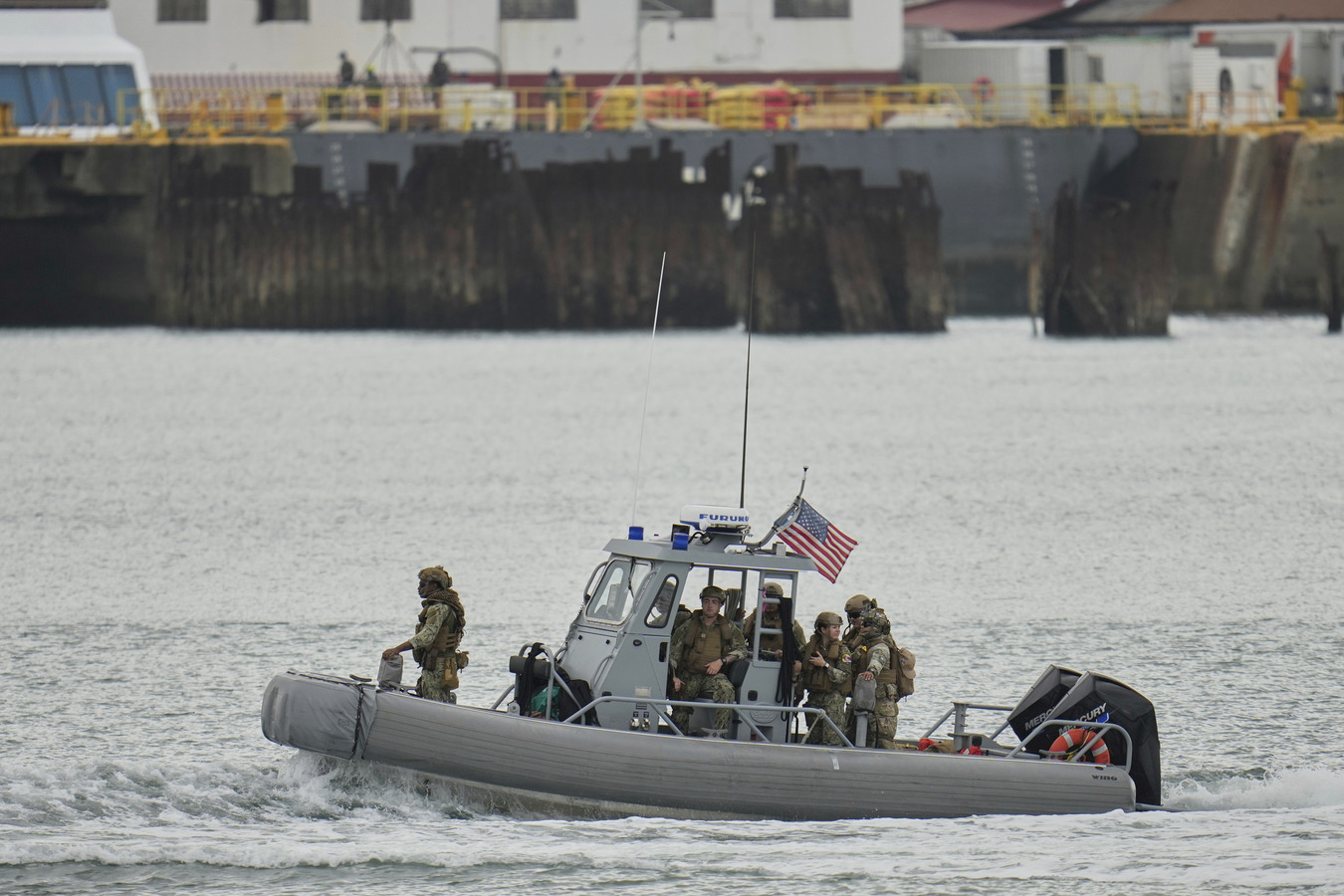Explainer: The FARC and Colombia's 50-Year Civil Conflict
Explainer: The FARC and Colombia's 50-Year Civil Conflict
How did the struggle between the guerrillas and the government begin, and where do peace talks stand today?
Updated May 12, 2016 — In 2014, the Revolutionary Armed Forces of Colombia turned 50 years old. So did Colombia’s civil conflict—involving the guerrilla group along with paramilitaries and drug traffickers—which has generated one of the world’s largest internally displaced populations, totaling 5.7 million in 2013. Over the years, the Colombian government has tried out various solutions to the conflict wrought by the group best known as the FARC. President Juan Manuel Santos started peace negotiations in 2012, and the two sides set March 23, 2016 as a deadline to sign an accord, however the date passed without an agreement. Since his 2014 reelection, along with a congress that includes former President Álvaro Uribe Vélez—traditionally a hard-liner against rebel groups—Santos has made the issue a focal point of his second term in office.
Explore by section:
- The Birth of the FARC
- Structure and Funding
- Past Peace Processes
- The Current State of the FARC and Peace Talks
- Timeline
The FARC argues that its program stems from a longstanding struggle between Colombian peasants and property owners over the fact that a small portion of the population owned a majority of the land in the early twentieth century. However, rivalry between the Conservative and Liberal parties dominated the nation’s attention in the mid-1940s, initiating a period termed La Violencia, or “The Violence.” Partisan tensions came to a peak on April 9, 1948, a day known as El Bogotazo, when liberal leader Jorge Eliécer Gaitan was assassinated on the streets of Bogota. With Gaitán seen as a martyr of the struggle against the oligarchies in power—and the Cold War as a global backdrop for inspiring leftist sentiment—uprisings spread throughout the country.
The first guerrilla groups sprang up in the fall of 1949 at the behest of the Colombian Communist Party (PCC), which urged peasants and farmers to form self-defense forces against “the terrorism of the state.” These groups began establishing “independent republics” in rural areas lacking a strong government presence. One of them, the Independent Republic of Marquetalia, sheltered future FARC leader Pedro Antonio Marín—alias Manuel Marulanda—in the Andean mountains southeast of Bogota. On May 18, 1964, the government responded to this defiance with Operación Soberanía (Operation Sovereignty), sending 2,000 soldiers to take back the rebel camps. However, Marulanda escaped before the troops arrived.
Two months later, the surviving forces—numbering just 48 men—came together for the signing of the Agrarian Program of the Guerillas, a document defining an internal hierarchy, strategy, and ideology for the unified group. But it was the FARC’s Seventh Conference in 1982 that transformed the guerrilla from a defensive group to an offensive national entity. The conference laid out an eight-year plan to take the capital, and focused on territorial expansion and the recruitment of 28,000 fighters by the time of deployment. Revisions at later conferences increased this number to 30,000 and added 20,000 militants, which are civilians who provide support on a temporary basis, unlike full-time combatants.
Initially, the guerrilla acted as the armed wing of the PCC, conceding political authority to the party. But by the 1990s, the once collaborative relationship fractured, and the FARC created its own political cells exhorting Marxist-Leninist ideals for improved worker conditions and pay. A seven-member Secretariat and the Central General Staff (approximately 30 members), which share top authority, coordinate all military and political designs of the guerrilla group. They also appoint leaders to each of the seven blocs, which are comprised of five or more fronts—each with between 50 and 500 combatants.
Although the guerrilla group never reached its 30,000-strong target, its numbers climbed steadily over the years. According to the Ministry of Defense, the FARC had 802 fighters distributed among nine fronts in 1978. A decade later, 3,640 combatants made up 33 fronts. In the late 1990s—the height of the group’s strength—the FARC counted approximately 18,000 fighters and held control over 42,000 square miles of land, a token from the government's peace negotiations in 1998.
The expansion plans of the Seventh Conference also led the group to increase its involvement in the drug trade. Initially, ideological disagreements kept the FARC from relying on drug-trafficking revenue, but the lucrative taxes some fronts were already raising from cocaine cultivation—particularly in the Putamayo, Caquetá, and Guaviare provinces—convinced FARC leaders to adopt the tactic. Consequently, most fronts implemented a tax on coca farmers, while some even managed their own laboratories. By 1987, nearly half of the fronts were concentrated in cocaine plantations. Colombia’s National Security Council estimates that the group made between $500 million and $800 million annually by the early 2000s—half of which came from cocaine profits. Other major income sources included extortion and ransoms from high-profile kidnappings. More recently, intercepted emails between FARC commanders show the group is facing a growing debt, leading traditionally strong blocs like the Eastern Bloc to expand extortion of oil companies.
|
Watch a conversation with President Santos on the peace process. |
Current President Juan Manuel Santos says Colombia is closer to ending the conflict than ever before. Past attempts fell short of succeeding, beginning with President Belisario Betancur’s administration in the 1980s.
In March 1984, Betancur’s government was the first to achieve a ceasefire with the signing of “La Uribe,” named for an area in the Meta province that was a FARC stronghold at the time. The agreement provided for the political inclusion of the group in return for their condemnation and cessation of kidnapping, extortion, and terrorism. The following year, the FARC created the Patriotic Union (UP) party and won 14 congressional seats, 14 provincial deputies, 23 mayoral offices, and 351 city council seats in the 1986 elections.
But the truce was doomed from the start. Betancur’s government never required the guerrilla group to disarm, perpetuating the use of violence and intimidation in the political arena. Meanwhile, right-wing paramilitaries opposed the peace talks and killed UP members—including presidential candidates Jaime Pardo in 1987 and Bernardo Jaramillo in 1990—inciting renewed aggression from the FARC. Succeeding President Virgilio Barco Vargas ended the ceasefire in 1987 and the UP broke from the FARC soon after. Still, approximately 3,000 UP members would die by 1990, leading to the party’s virtual disappearance from politics. On December 9, 1990—during President César Gaviria’s administration—the armed forces launched a surprise attack on FARC headquarters, intending to force the guerrilla into resuming negotiations, but only heightening their aggression.
The next break in hostilities came during Andrés Pastrana’s presidency. In October 1998, the government initiated the Caguán Peace Talks by demilitarizing a 42,000-square-mile zone to hold negotiations with the FARC. Already a FARC stronghold, the central-southern area of the country was now completely controlled by the guerrillas. Meanwhile, each side carried out separate agendas. For example, the FARC continued armed attacks, including the murder of three U.S. missionaries in 1999. With kidnappings at an all-time high of 3,500 per year in 2000, the government launched the U.S.-backed program known as Plan Colombia. The package gave Colombia approximately $500 million a year to revamp its armed forces and combat crime and drug trafficking. Finally, a series of high-profile kidnappings, like that of Senator Jorge Géchem Turbay in 2001, forced Pastrana to end negotiations on February 20, 2002. The FARC retaliated with the kidnapping of presidential candidate Ingrid Betancourt three days later.
The Current State of the FARC and Peace Talks
The FARC’s armed forces have been slashed by more than half since their peak, leaving approximately 7,000 combatants, along with 15,000 militants today. This decline stems from President Álvaro Uribe’s Democratic Security policy introduced in 2003. Through a refitted military and national police, the government worked to take back lost territory and draw down rebel forces, focusing also on strengthening institutions and infrastructure in rural areas. From 2003 to 2007, the armed forces’ combat activities grew 150 percent compared to the prior four years. In 2007, the FARC registered its lowest number of armed actions to that point.
Then, the guerrilla group’s strength hit an all-time low in 2008. On March 1, a Colombian military raid on a FARC camp in Ecuador killed second-in-command FARC leader Raúl Reyes. The military also seized several computer devices that allegedly revealed financial ties between the guerilla group and Presidents Hugo Chávez of Venezuela and Rafael Correa of Ecuador. By the end of the month, top commander Manuel Marulanda died from natural causes. Finally, the successful rescue of 15 hostages, including Ingrid Betancourt in July 2008, dealt the group another blow and marked a 20-year low in kidnappings in the country.
After nearly a decade of a military approach, President Juan Manuel Santos revived negotiations in 2012. That year, a set of exploratory talks from February 23 to August 26 produced a document that outlines a set agenda of six points to be discussed in meetings: rural agrarian development, political participation, illicit drug trafficking, victims’ reparation, disarmament, and implementation procedures of the accords. Since the official start of negotiations in Havana, Cuba, on November 18, 2012, the government and the FARC have reached at least partial consensus on five of those points. So far, elements of the agrarian accord include the creation of a land fund to hand out millions of acres to peasants, along with rural development of infrastructure, education, and health services. Regarding political participation, opposition groups will receive more representation in Congress—though the government has not specified to what degree—and access to public airwaves. As the FARC discontinues its drug-related activities, the government will combat narcotrafficking and create prevention and rehabilitation programs for addicts.
In September 2015, the two sides reached a critical agreement on transitional justice, and set the March 23, 2016 deadline.
Under the agreement, special tribunals will be created to try demobilized FARC members who participate in the peace process. The tribunals will also determine which ex-members are guilty of political participation in the group and which are guilty of more serious crimes like politically motivated assassinations and war crimes.
Sentencing will focus on restorative justice over punitive measures. If guerrilla members comply with the terms of the peace agreement, they avoid prison—as well as extradition—and will be subject to house arrest for up to eight years. But if FARC members fail to acknowledge any participation in guerrilla activities or are found to have lied about participation, they will be subject to traditional justice and jail time. Those who confess to simple political involvement with the guerilla group can face up to eight years of house arrest. Those found guilty of serious crimes face can face up to eight years in prison, but can get reduced time if they commit to working or studying during their sentence.
Meanwhile, military officers who committed illegal acts during the conflict—such as those accused of participating in the “false positives” scandals—will be tried in the same special tribunals; if found guilty, they will serve time in a military prison. Members of the military will also lose their judicial privileges if they are found to not have disclosed what they knew about the conflict.
|
Listen to ACR Director Alejandro Eder break down reintegration numbers. |
Unlike past peace attempts, the government opted not to concede to a bilateral ceasefire, given the FARC’s tendency to replenish forces during such periods. “A ceasefire will be a perverse incentive for the FARC to prolong negotiations eternally,” said Santos at a September 2014 event at AS/COA. “Because they will be in the best of all worlds. Armed, with dialogue, and no military pressure.” On December 17, 2014, the FARC announced a unilateral ceasefire. In March 2015, the government reciprocated by announcing it would halt the bombing of FARC camps. The following month, however, FARC guerrillas attacked and killed 11 soldiers and injured 17, prompting Santos to retract the airstrike ban. In July 2015, with public opinion and Santos’ own patience at low points, the FARC agreed once again to a unilateral ceasefire.
While the FARC still recruits fighters and militants, but government initiatives continue to trim away at their numbers. The Colombian Agency for Reintegration (ACR) has helped demobilize 18,000 FARC members since 2003, with a 20 percent uptick in 2013 that saw the reintegration of 1,100 ex-FARC combatants.
The guerrillas’ actions have put the peace talks in jeopardy on several occasions. In November 2014, Santos suspended talks after the FARC kidnapped an army general. The general was released by the end of the month and talks resumed in December. On February 18, 2016, chief FARC negotiator Iván Márquez and other high-ranking guerrillas were seen talking to civilians in a rural town while armed guerillas stood nearby—a violation of the talks’ terms.
As the March 23 deadline neared and several key points remained unresolved, both sides began to back off the deadline. "I am not going to sign a bad agreement just to meet a deadline,” Santos said on March 9. A poll published two days afterward showed that 66 percent of Colombians felt pessimistic about the peace talks, while Santos approval dropped to 25 percent.
On March 22, U.S. Secretary of State John Kerry, who was accompanying President Barack Obama on his historic trip to Cuba, also had an unprecedented meeting: with the FARC delegation in Havana, at which he reassured them of U.S. support of the peace process. The next day, both sides acknowledged they would not be signing a deal on the original March 23 deadline, but did say that the negotiations are still ongoing and that expect to sign a final peace agreement this year. “2016 will be the year of peace,” said Márquez.











